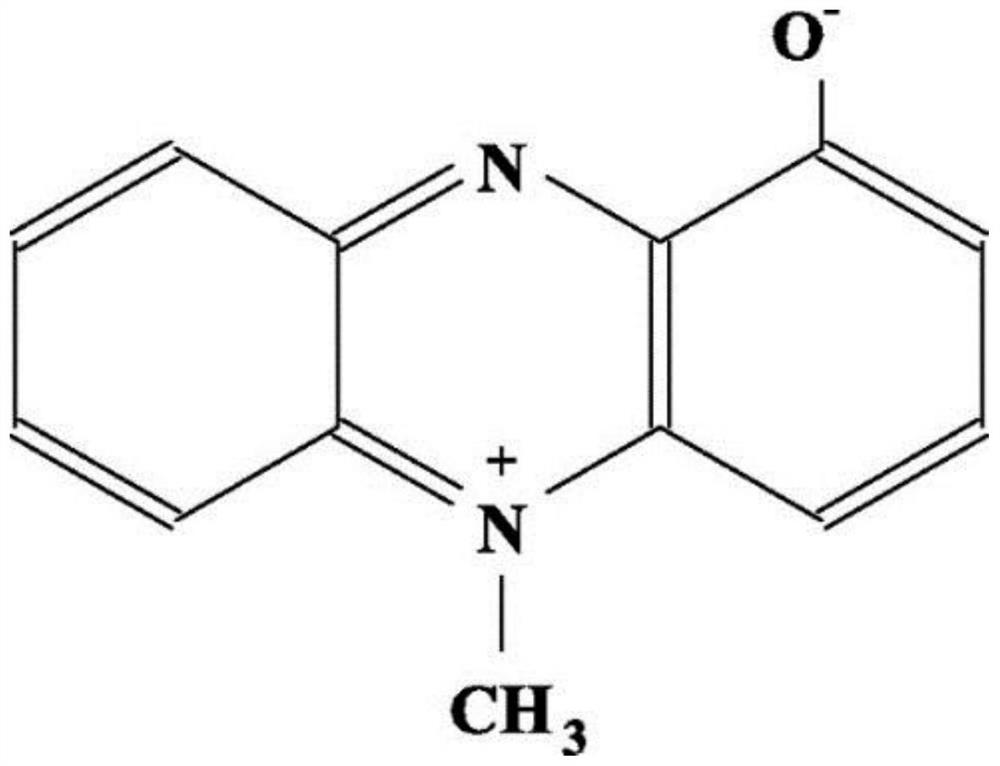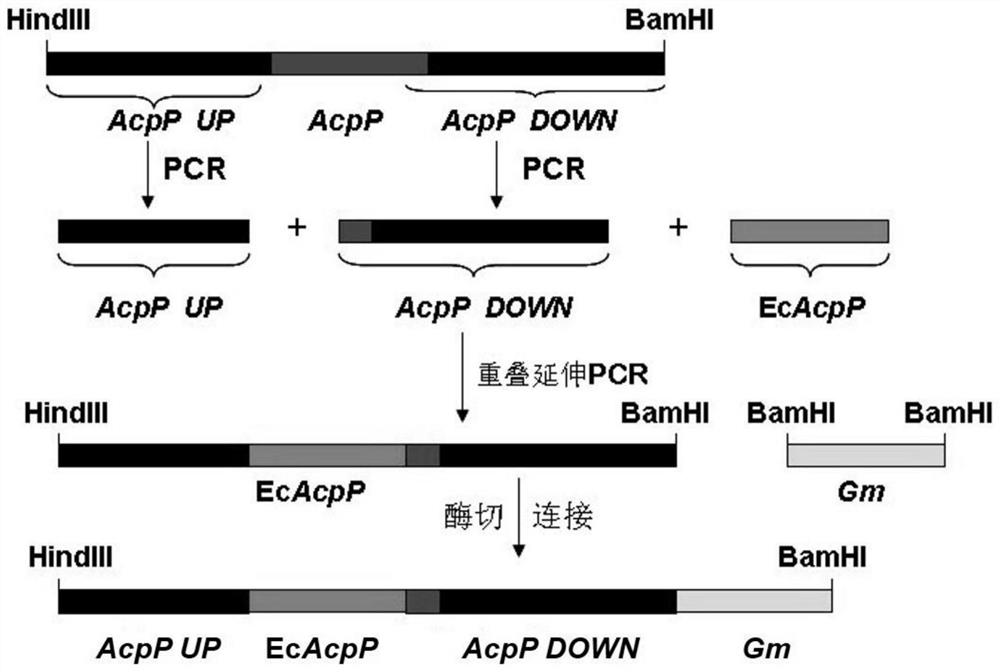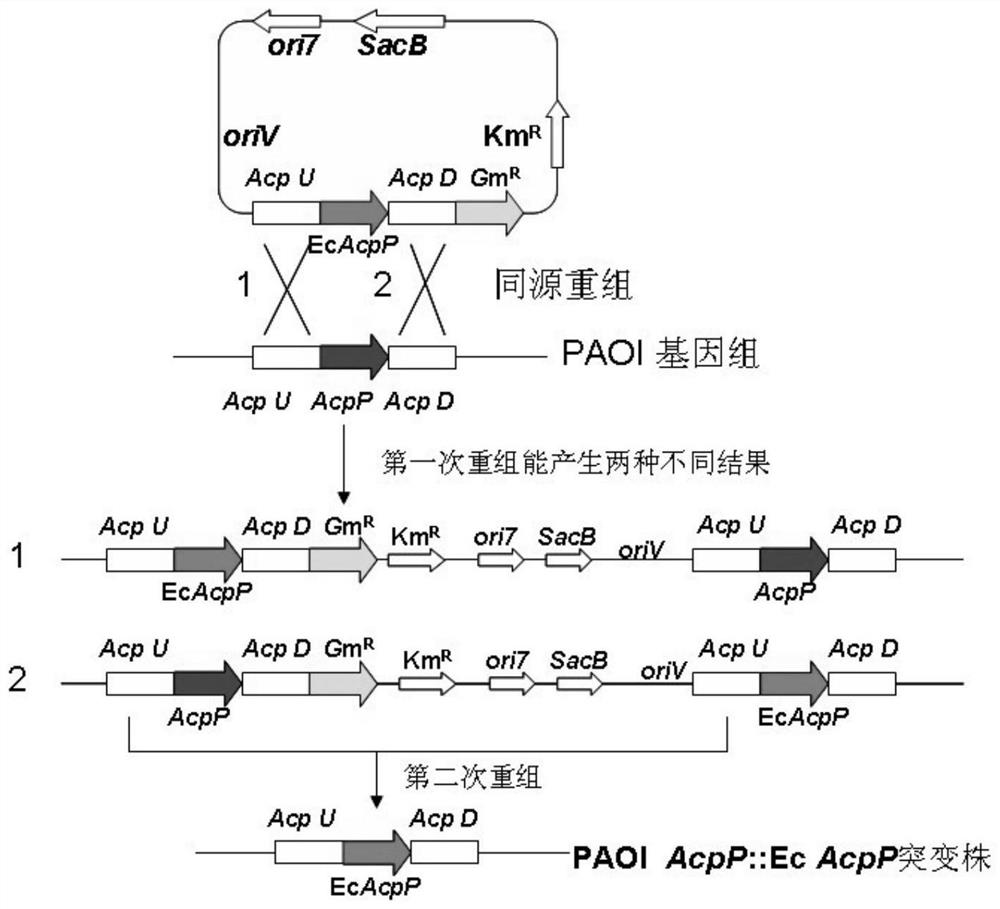High-yield pyocyanin engineering bacterium and construction method and application thereof
A pyocyanin and engineering bacteria technology, applied in the field of genetic engineering, can solve the problems of bacterial inability to carry out metabolic transport, cell death, accelerated bacterial oxygen consumption, etc.
- Summary
- Abstract
- Description
- Claims
- Application Information
AI Technical Summary
Problems solved by technology
Method used
Image
Examples
Embodiment 1
[0041] Construction of PA-A1(ΔPa acpP::Ec acpP) Gene Knockout Mutant
[0042] According to the PA2966 gene and its upstream and downstream sequences, design primers (the underlined part is the restriction site):
[0043] P1 (SEQ ID NO.3):ATAATC AAGCTTT GCGCATGAAAGACGACGAG
[0044] P2 (SEQ ID NO.4):TAGTGCTCATACCTTGTTTTCACTCCTATGG
[0045] P3 (SEQ ID NO.5):AAAACAAGGTATGAGCACTATCGAAGAACG
[0046] P4 (SEQ ID NO. 6): TCTCGAATTCTTACGCCTGGTGGCCGTCGATG
[0047] P5 (SEQ ID NO.7):ACCAGGCGTAAGAATTCGAGACCGAAATCCC
[0048] P6 (SEQ ID NO.8): CGCCGA GGATCC AACCCATGGATACGCCGATAC
[0049] P7 (SEQ ID NO.9): TGGTCATCGGCACCGCGACCAGCGCGTC
[0050] P8 (SEQ ID NO. 10): CGGCCTCGCCATAGGCGATGTTGCGAGC
[0051] In order to obtain the PA-A1 (ΔPa acpP::Ec acpP) mutant strain, the present invention first constructed an acpP knockout vector. First, using the total DNA of Pseudomonas aeruginosa PAO1 as a template, amplify with P1 / P2, P3 / P4 primers respectively to obtain about 500 bp fragments of th...
Embodiment 2
[0055] Detection of Pyocyanin Content in PA2966 Gene Replacement Mutant Strain PA-A1
[0056] The extraction and detection of pyocyanin refer to the following methods:
[0057] 1. Inoculate Pseudomonas aeruginosa into a 15mL centrifuge tube with 5mL LB liquid medium, and culture overnight at 37°C with shaking.
[0058] 2. Transfer 5mL of the seed solution to 100mL of the pyocyanin production medium, the capacity of the Erlenmeyer flask is 250mL, and put it into a shaking incubator at 37°C, with a rotation speed of 200rpm.
[0059] 3. Take 5 mL of bacterial cells every 4 hours, centrifuge at 4000 rpm for 10 minutes, and collect the supernatant.
[0060] 4. Add 3 mL of chloroform, fully extract, and remove the lower organic phase.
[0061] 5. Add 1 mL of 0.2M HCl to the lower organic phase and shake vigorously for 1 min.
[0062] 6. Take 200 μL of the upper aqueous phase and detect the OD520nm value.
[0063] 7. Pyocyanin concentration (μg / mL) = OD520nm value × 17.072.
[0...
Embodiment 3
[0070] Determination of Pyocyanin Production of PA-A1 Mutant Strains in Different Production Mediums by Shaking Flask Fermentation
[0071] The growth of microorganisms and the production of metabolites are affected by many aspects such as nutritional conditions and culture conditions. In this study, by reviewing the literature, a variety of pyocyanin production media were collected, including GA medium, PDP medium, FD medium, and PPM medium, and wild-type PAO1 and PA-A1 mutant strains were cultivated to detect P. aeruginosa The concentration of pyocyanin was used to screen out the most suitable medium for the production of pyocyanin by the PA-A1 mutant strain. The result is as Figure 7 shown.
PUM
 Login to View More
Login to View More Abstract
Description
Claims
Application Information
 Login to View More
Login to View More - R&D
- Intellectual Property
- Life Sciences
- Materials
- Tech Scout
- Unparalleled Data Quality
- Higher Quality Content
- 60% Fewer Hallucinations
Browse by: Latest US Patents, China's latest patents, Technical Efficacy Thesaurus, Application Domain, Technology Topic, Popular Technical Reports.
© 2025 PatSnap. All rights reserved.Legal|Privacy policy|Modern Slavery Act Transparency Statement|Sitemap|About US| Contact US: help@patsnap.com



